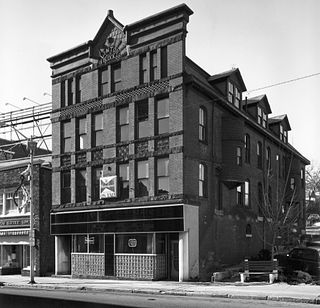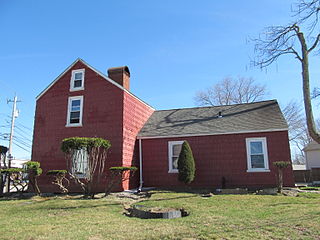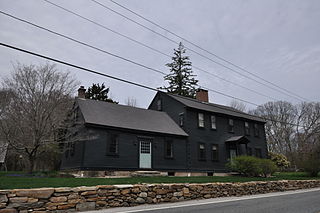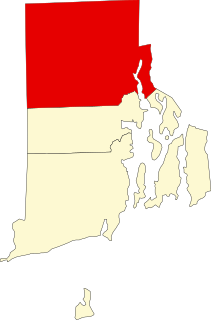
The Eleazer Arnold House is a historic house built for Eleazer Arnold in about 1693, and located at 487 Great Road, Lincoln, Rhode Island in the Great Road Historic District. It is now a National Historic Landmark owned by Historic New England, and open to the public on weekends.

The Clemence–Irons House is a historic house at 38 George Waterman Road in Johnston, Rhode Island. It was built by Richard Clemence in 1691 and is a rare surviving example of a "stone ender", a building type first developed in the western part of England and common in colonial Rhode Island. The house is listed on the National Register of Historic Places, and is a historic house museum owned and operated by Historic New England. It is open Saturdays between June and mid-October.

Union Village or "Bank Village" is a village and historic district located in North Smithfield and Woonsocket, Rhode Island on Rhode Island Route 146A. Union Village developed because it was at the cross roads of old Great Road and Pound Hill Road.

The Nightingale–Brown House is a historic house at 357 Benefit Street on College Hill in Providence, Rhode Island, United States. It is home to the John Nicholas Brown Center for Public Humanities and Cultural Heritage at Brown University. The house is architecturally significant as one of the largest surviving wood-frame houses of the 18th century, and is historically significant as the longtime seat of the Brown family, whose members have been leaders of the Providence civic, social, and business community since the 17th century, and include nationally significant leaders of America's industrialization in the 19th century. The house was listed on the National Register of Historic Places and declared a National Historic Landmark in 1989.

The Smithfield Friends Meeting House, Parsonage and Cemetery, is a Friends Meeting House of the Religious Society of Friends (Quakers), rebuilt in 1881. It is located at 108 Smithfield Road in Woonsocket, Rhode Island. The meetinghouse is home to one of the oldest Quaker communities in the region.

The Israel Arnold House is an historic house on Great Road in Lincoln, Rhode Island. It is a 2-1/2 story wood frame structure, set on a hillside lot on the south side of Great Road. The main block is five bays wide, with a central chimney rising through the gable roof. A 1-1/2 story gambrel-roofed ell extends to one side. The ell is the oldest portion of the house, built c. 1720 by someone named Olney. The main block was built c. 1760. The house was owned into the 20th century by four generations of individuals named Israel Arnold.

The Cato Hill Historic District is a residential historic district in central Woonsocket, Rhode Island. It consists of about 2-1/2 blocks of Church and Cato Streets, as well as the streets crossing them. The area, located on a hill just above Woonsocket's downtown area, is a densely populated area built primarily between 1838 and 1875, during Woonsocket's growth as a major textile processing center. Cato Hill is named for Cato Aldrich, an African American who purchased the land from the Arnolds who founded Woonsocket. The houses of the district exhibit vernacular forms of the architectural styles popular in the mid-19th century.

The Grove Street Elementary School is an historic school at 312 Grove Street in Woonsocket, Rhode Island. The two-story brick Stick/Eastlake style school was designed by E.L. Angell of Providence and built in 1876. In c. 1885 it was enlarged by adding a matching addition to its rear, joined by a small hyphen. This addition is more Queen Anne in its styling.

Honan's Block and 112—114 Main Street are a pair of joined commercial buildings at 110-114 Main Street in Woonsocket, Rhode Island. Honan's Block is a visually distinctive three-story brick Stick/Eastlake-style building erected in 1879. The adjacent 112-114 Main Street is an L-shaped two-story block which wraps around the rear of the Honan Block. The two buildings were joined via internal connections in 1938-39, at which time the facades of both buildings were significantly altered, although the Honan Block has retained its distinctive Late Victorian cast-iron elements.

The Jenckes Mansion is an historic house at 837 Social Street in Woonsocket, Rhode Island. This three-story brick double house was built in 1828 by the Jenckes family, owners of the mills around which this area of Woonsocket, known as Jenckesville, grew. The building exhibits late Federal styling, and is distinctive as a rare example of a period private residence with ballroom. This space, located on the building's attic space, was divided into residential spaces c. 1900, when the building was converted into a tenement house.

The Linton Block was a historic site at 3-5 Monument Square in Woonsocket, Rhode Island.

The Logee House is an historic house on 225 Logee Street in Woonsocket, Rhode Island. Built in 1729 by a French Huguenot family, this two-story wood frame house is a rare early-18th-century house in the city, and one of its best-preserved. The main block follows a plan more typical of colonial Massachusetts houses, unsurprising given the land it stands on was once disputed between the two colonies. The main block has a central chimney, with single rooms on either side on both floors. An ell, probably 18th century in origin, extends from the rear, and a 20th-century porch adorns the front of the house.

The Main Street Historic District is a historic district in the central business district of Woonsocket, Rhode Island, USA. It extends along Main Street, between the railroad tracks just northeast of its junction with Clinton Street, and roughly Ascension Street at the southwest. Most of the sixteen buildings in this area were built at the height of Woonsocket's prosperity, roughly between 1850 and 1930. The district is characterized by brick and masonry buildings generally between two and six stories in height.

The Mount Vernon Tavern, also known as the Bank House Tavern, is an historic house in Foster, Rhode Island. It is located at 199 Plainfield Pike, about 3/10 of a mile east of its junction with Howard Hill Road. The main block of the house, a 2-1/2 story wood frame structure with gable roof, was built c. 1760, and was originally attached to an even older structure which was demolished in the late 19th century. This main block, five bays wide with a central chimney, is attached to a 1-1/2 story gable-roofed ell to the west. The main entrance portico features unusually elaborate Federal styling for a rural location, and was probably added in 1814. The house has long been a landmark on the road, serving as a stagecoach stop on what was the main road between Providence and points in Connecticut.

Woonsocket Rubber Company Mill is an historic mill at 60-82 Main Street in Woonsocket, Rhode Island. The mill consists of a series of 3- and 4-story brick buildings built between 1865 and 1875 by Edward Harris, one of Woonsocket's leading businessmen. These buildings housed the Woonsocket Rubbert Company, one of Rhode Island's first manufacturer of rubber products, principally shoes, boots, and rubberized fabric. In 1910 the complex was purchased by the Falls Yarn Company, which used it for the production of fine woolen yarns.

The Woonsocket District Courthouse is an historic court building on 24 Front Street in Woonsocket, Rhode Island.

The St. Charles Borromeo Church Complex is an historic Roman Catholic Church in Woonsocket, Rhode Island on North Main Street within the Diocese of Providence.

The Morris Brown House is a historic house located at 317 Rochambeau Avenue in Providence, Rhode Island. The house was listed on the National Register of Historic Places on August 22, 1991.

The U.S. Post Office is a historic former post office building at 295 Main Street in Woonsocket, Rhode Island. The single-story masonry building was built 1910-12 and served as Woonsocket's main post office until 1975.

The Esten–Bowen House is a historic house at 199 Iron Mine Road in Burrillville, Rhode Island. The 1 1/2 story timber frame Cape style house was built c. 1790 by John Esten, a major landowner in eastern Burrillville in the second half of the 18th century. The main block is five bays wide and two deep, with a massive central chimney. A kitchen ell to the right of the main block appears to be an early addition. The house was held in the Esten family until 1879, by which time its surrounding property had been reduced to just 30 acres (12 ha). This property was acquired by Esther Bowen in 1941 and the house was rehabilitated, with modest Colonial Revival alterations. The property includes a 19th-century shed, and foundational remnants of a blacksmithy and barn.

























